The Language of Colours
Just as colours are important for people in making sense of their surroundings, so are they indispensable for other living beings to survive.
 |
| Mother birds feed their chicks according to the colours of their gapes. |
Living beings have a "colour language" that works according to the light and the systems of perception they possess. Different colours bear different meanings for every living being. In order to survive, every living being has to know the language of colours used in its habitat, because vital functions can only be controlled by acknowledgement of this language. So, how do living beings use this colour language?
First, the majority of living beings need the help of colours in order to find food. Second, the colours that exist on formations such as skin, scales and fur play an important role in the continuity of life due to their characteristics of absorbing or diffusing heat. In addition, living things use their colourings to protect themselves from their enemies. Owing to colours that harmonise with their habitat, they can camouflage themselves and hide from their enemies. Alternatively, their colourings and patterning may pose a discouraging image for their enemies. Colours also help animals to recognise their mates and chicks. A mother bird, for example, understands whether her chicks need food or not from the colours of their gapes. Similarly, the chick recognises its mother in this way and understands that the food has arrived.16 As seen in these examples in nature, living beings need to know the meaning of colours in order to survive. In order to attain this knowledge correctly they need to possess proper systems of perception.
If they did not have these systems, they would not be able to perceive their surroundings properly or carry out their vital activities. They would not be able to recognise their foods or discriminate their enemies. Therefore, in this latter case they would stand out from the outside world and be an easy prey doomed to death.
Surely, no one can claim that such sophisticated systems might have come into existence by coincidence. Every system, every harmony, every design, every program, every plan, every balance must be created by a designer. There is certainly a higher will and power that has perfectly placed this harmony in living beings and the habitats in which they live. The owner of this power encompasses both the surroundings and the living being itself and the systems it uses with a higher knowledge. The owner of this power is Allah, Lord of the worlds. When we examine living beings, we see how skilfully they employ the language of colours.:
Here are some examples of the language of colours, which has such an important place in the life of living beings
 |
| Allah creates every colour on earth. The sky, mountains, crops, butterflies, red apples, oranges, parrots, pheasants, violet grapes, trees, in short, everything you see in your surroundings, possess these colours because Allah wills so. Allah states this fact in a verse as follows: |
| Do you not see that Allah sends down water from the sky and by it We bring forth fruits of varying colours? And in the mountains there are streaks of white and red, of varying shades, and rocks of deep jet black. And mankind and beasts and livestock and likewise of varying colours. Only those of His slaves with knowledge have fear of Allah. Allah is Almighty, Ever-Forgiving. (Surah Fatir: 27-28) |
Camouflage
Camouflage is one of the most effective defence tactics that animals use. Self-camouflaging animals are under some kind of protection because of their body structures, which are created in great harmony with their habitats. The bodies of these animals are so harmonious with their environments that when you look at their pictures, it is almost impossible to tell if they are plants or animals, or to distinguish an animal and a plant present in the same environment from each other.
The living creatures that adapt their colourings according to the environments in which they live have always attracted the attention of scientists. Research focuses on finding an answer to the question of how a living creature can look exactly the same as a creature that is of a completely different structure.
Have you ever thought, for instance, how a frog, which, while walking in the garden, you took for a leaf, and then at the last moment skipped a step and avoided stepping on it, has it come to possess these patterns and colour? Camouflage is a very important defence mechanism for a frog. The frog that is unnoticed in its environment easily loses its enemies.
While a pink spider on a pink flower can successfully take on the flower's different shades of pinks of, another member of the same spider species can adapt to the colour of another flower, for instance, a yellow one, when it climbs on it.
(Surat al-Isra': 44)
While someone is looking at a branch, thinking there is nothing on it, a butterfly may fly away from it all of a sudden. This butterfly, which looked exactly like a leaf down to the dry, autumn-withered parts a second ago, is a perfect example of the miracle of camouflage.
As will be seen in the following pages, the similarity of living creatures to the objects on which they rest prevents their enemies from noticing them. It is obvious that these camouflaging creatures have not made themselves, on their own initiative, look like leaves, branches or flowers. What's more, they are not even aware that they are protected because of these similarities. Nevertheless, they employ camouflage very skilfully in all our examples without exception. An insect having the same colour as a flower, a snake standing still as a tree's branch, a frog adapting to the colour of wet ground, in short, all self-camouflaging creatures are evidence proving that camouflage is a specially created defence tactic.
No living creature can perform such a task on its own or by coincidence. Certainly, He Who bestows upon living creatures the ability to camouflage themselves, and places the chemical processes in them by which they can carry out this colour change, is Allah, the All-Knowing, the All-Wise.
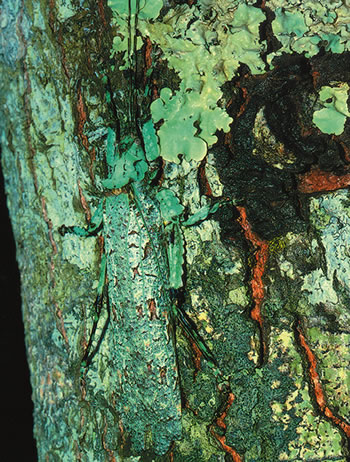 |  |
| In the picture is a grasshopper imitating the bark of a tree. The camouflage employed by the grasshopper is so perfect that even the designs of the lichens on the tree are present on it. This is a perfect creation of Allah. | The Misumena varia species of crab spiders seen on the left can assume different colours ranging from yellow to white, depending on the flower on which they land.17 The spider species seen above stops moving only when the colour and configuration of the plant are those best suited to hide it.18 |
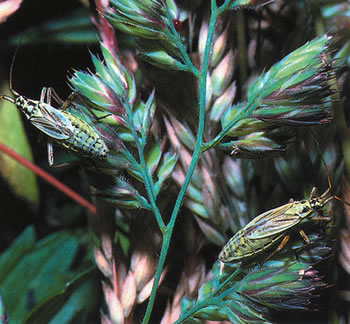 |  |
| In the photograph on the left are two myriapods that have developed almost identical coloration to the plants on which they live. In this way, they are protected from their enemies.20 | Some insect species protect themselves from their enemies by means of group camouflage. For instance, Phiatids, a species of tropical Hemiptera found in Madagascar, has full and brilliantly coloured wings. When they are resting on a tree trunk, as in this photograph, they resemble an inflorescence.19 This misleads the hunters that look for insects. |
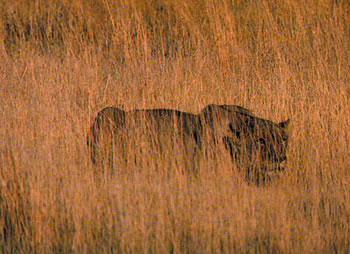 |  |
| In the dry grass of the savannah, a hunting lioness is almost invisible, as the colours of the lioness tend to blend with the environment. | The cheetah is no easier to distinguish in the tall grass; this is because hundreds of small spots break up the lines of the animal's body. The bright sunlight emphasises the black spots of the cheetah, increasing the mottled or "broken" effect of the body's outline.21 |
 | 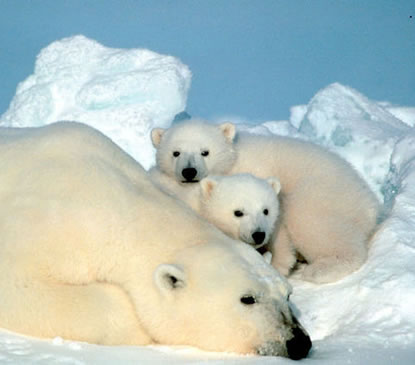 |
| The polar bear's dense, white fur, combined with layers of fat beneath the skin, protects him from the bitter cold. But the white fur serves another purpose – it serves as camouflage when the bear is hunting. In the same manner, white fur provides a good protection for rabbits that live in snow. | |
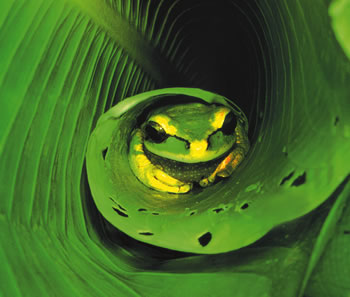 | 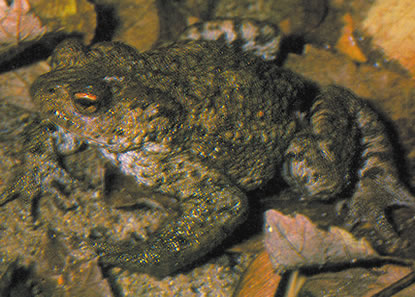 |
| Camouflage does not only take place on the surface of the skin. The muscles of some species of frogs that live in the tropical forests of South America are coloured. The blood contains oxygen-conveying cells. Therefore, changes brought about by the need for camouflage not only take place on the surface of the skin but also within the body.22 | Dead twigs and leaves become dark when wet. In the same manner, frogs and toads also change colour in wet weather, becoming darker. This change makes sure that they remain well camouflaged among the wet twigs and leaves.23 It is not possible for this amazing harmony to be coincidental. |
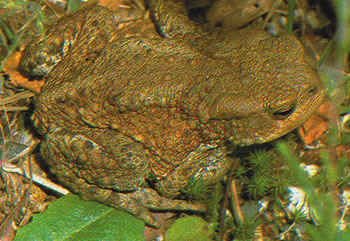 | 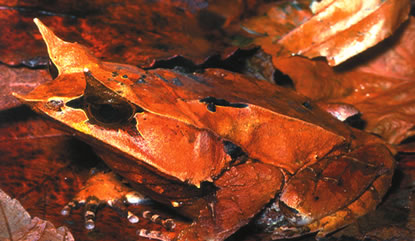 |
| In the picture there is a land frog that changes its colour according to weather conditions. | A small, leaf-shaped frog blends in with the substratum of a forest in Malaysia. The frog is best camouflaged when viewed from above – that is, from the angle at which the predator is most likely to view it.24 |
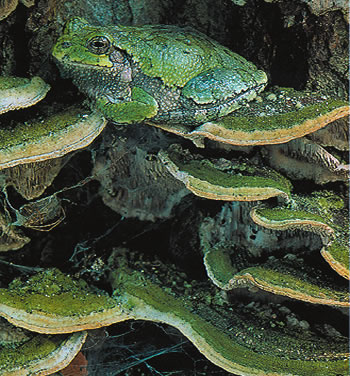 |  |
| In the picture to the right is a frog of another species, which appears like part of the tree. It is quite difficult to distinguish both living things from the environment. | The patterns on the grasshopper below are very similar to traces of a kind of parasitic fungus on leaves. In addition, since its long legs could betray a grasshopper's presence, the legs of some grasshoppers, as is the case with the grasshopper seen here, are almost transparent.27 Surely, the animals themselves do not consciously choose to do these imitations that are so perfect as not to leave out the dry parts and folds of a leaf. Allah, Who creates everything perfectly, created the grasshoppers. |
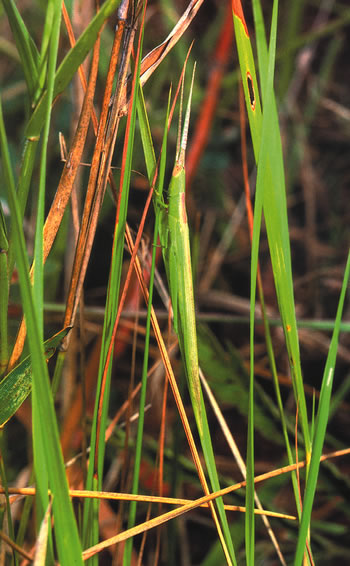 | 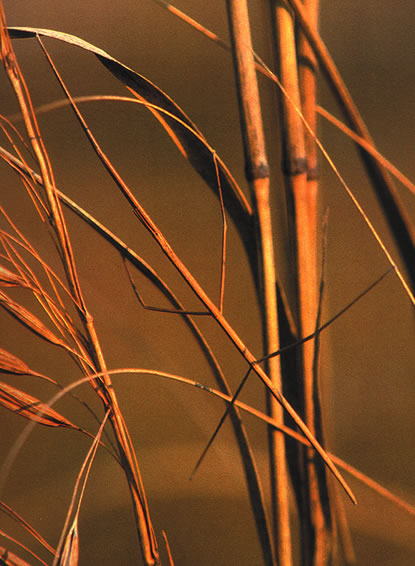 |
| In the daytime, or during the hours when predators are most active, the majority of mimetic animals remain immobile. Even the slightest movement could betray their whereabouts. The sensory apparatus of a predator is extremely sensitive to movement. For instance, this Brazilian grasshopper is indistinguishable from the blades of grass upon which it has landed.25 | Pictured to right is a stick insect. Stick insects camouflage themselves in order to escape their predators. Mimetic ability, however, is not confined to adult insects in myriapods; the eggs are also camouflaged. On the ground, they look very much like vegetable seeds.26 It is impossible for a living creature to create colours in its body so as to be the same as its environment or to make its shape resemble that of another species. Allah, Who is their Creator, has given these features to all camouflaging creatures. |
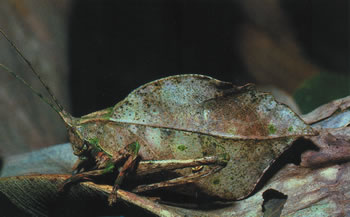 | 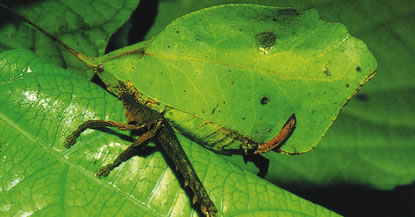 |
| In the photographs grasshoppers are seen imitating leaves. A central vein and two symmetrical halves on two sides of this vein, which are present in the general structure of leaves, are also fully present in these grasshoppers as seen in the photographs. | |
 | 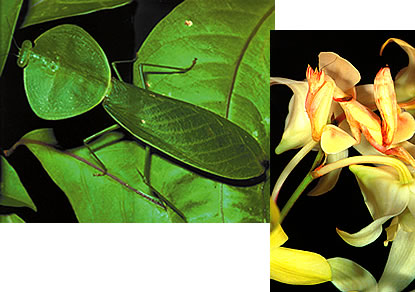 |
| In the top left photograph is a mantis, which is almost invisible among the pink flowers. As opposed to the majority of other mantises, whose bodies have a long and narrow first segment or prothorax, in this Costa Rican species (the large photograph) this segment has a different design that makes it similar to the leaves on which the mantis lives. | Mantises are among the most common predators in the forests and in the savannahs of the hottest regions of the globe. The entire body structure of a mantis is designed for predation. The nymph mantis, seen below, of the tropical forests of South America is almost identical to the dry leaves of the fern. If it were to rest on a green leaf, it would be easy to spot. Most species take great care to find suitable environments in which to lie in wait for their prey.28 It is certainly not possible for this creature to have devised such a system on its own. He Who inspires all the creatures with how they are supposed to act is Allah, the Lord of the entire universe. |
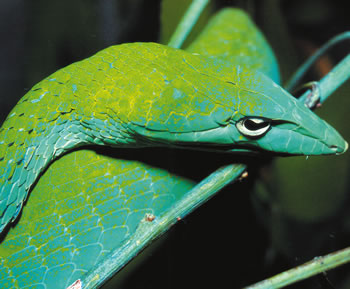 | 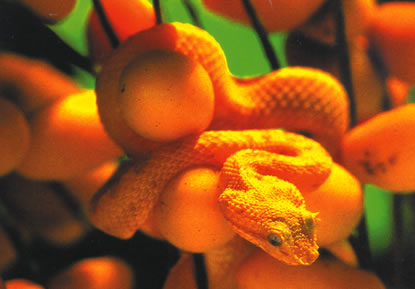 |
| The whip snake of South East Asia lives in trees and is covered with green scales. These scales, which cover the upper part of the snake's body, are camouflaged to look like the patina of lichens and algae that covers the trees. | It is almost impossible to distinguish the snake species that inhabits the tropical rainforests of Costa Rica from the tree on which it rests. |
 | 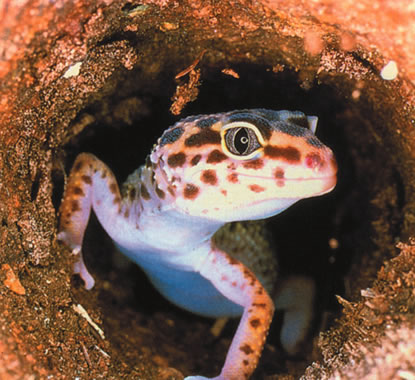 |
| The Australian leaf gecko usually lives near trees, and closely resembles bark. It rarely displays its pale abdomen. Even the lizard's eyes are well camouflaged. (left) | In the case of this leopard gecko from Pakistan, only the upper body imitates the substratum upon which it might be detected. The abdomen is almost entirely white, because the small reptile is always careful not to reveal that particular part of its body. (above)29 |
Camouflage techniques of reptiles
What does a reptile do to protect itself against its predators in the wild? One of the easiest ways for these slow-moving creatures is definitely to conceal themselves. The best method of hiding is adaptation of the creature's body to its habitat. Colours and patterns usually serve as a lifesaver for many animals. For example, in the forest it is almost impossible to distinguish a Rhino Viper, a kind of tropical snake living in the rainforests of Africa, due to its skin being covered with blue, red, yellow, black and white geometric patterns. Interestingly, the colours of the snake match the surroundings in which it lives. This one-to-one relationship evokes some questions in the mind. How did these colours, which harmonise with the environment so well, emerge? Is it possible for this to have happened by chance, or to have been produced by the reptile itself?
Certainly, it is not possible at all. It is impossible for a reptile first to analyse its environment, then to decide what kind of changes it needs to make in itself, and finally to determine a colour and pattern. Furthermore, it is totally illogical and unreasonable to claim that it might have set up a system in its body to carry out the chemical reactions that are necessary for such a change.
Even man, the only living being endowed with reason on earth, cannot change the colour of any part of his body. He cannot establish a system in his body to bring about such a change. In this case, there is only one explanation for the perfect resemblance of the colour of the reptile to the colour of its surroundings to such an extent that even the shades do not differ. An infinitely superior possessor of wisdom has designed this living creature. This design belongs to Allah, the Almighty. Allah is He Who knows best the needs of every living being.
The Most Famous Camouflaging Reptile: the Chameleon
 |
| The squid and octopus can also change their colours rapidly. Sometimes it appears as if waves of colour are pulsating across their bodies. Lots of different things set off these changes – anger, the sight of food, fear, and the colour of the background.31 Allah has created these beings along with the features that will help them to protect themselves under the sea. Allah is the All-Encompassing, the All-Knowing. |
Have you ever seen a chameleon changing its colour according to its surroundings? This is indeed something worth seeing. The chameleon has such an exceptional ability to camouflage itself that its deftness astonishes everyone. Although many other reptile species have the ability to change their colours, none of them is capable of doing it as rapidly as chameleons.The chameleon uses red and yellow colour carriers, blue and white reflector layers and most importantly "chromatophores", skin cells that respond to variations in heat, light and the animal's mood.30 If you put a chameleon in a very yellow setting, for example, you would see that the colour of its body instantly turns yellow and adapts to its surroundings. What's more, chameleons adapt not only to a single colour, but also to multicoloured substrata. The secret of their achievement is the colour cells, lying under the skin of this master of camouflage, which magnify and swiftly change place to adapt to the environment. Could a chameleon make such a perfect adaptation on its own? How do these creatures indistinguishably blend in with the environments in which they live, while even the most skilful artist has to work for hours to obtain the equivalent of a single natural colour?
It would surely be unreasonable to claim that a chameleon could perform such an act of its own volition. It is certainly not possible for a reptile to determine the appearance of its body, nor to place a system in its body to change its appearance. It would be just as nonsensical to claim that this creature has control over all the cells and atoms in its body, that it is capable of making whatever change it wishes on them and produce the required pigments. It is totally inconsistent and meaningless to claim that such an exceptional ability has come into being by chance. No mechanism in nature has the power of producing such perfect skill and granting it to the being that needs it. Just as all other living beings on earth, Allah also created chameleons. Allah demonstrates to us the uniqueness of His artistry in creation with these examples. Allah is the Almighty, the All-Wise.
Everything in the heavens and the earth glorifies Allah. He is the Almighty, the All-Wise. The kingdom of the heavens and the earth belongs to Him. He gives life and causes to die. He has power over all things. (Surat al-Hadid: 1-2)
 |
| Chameleons are one of the best self-camouflaging animals. As seen in the photographs above, the cool shadow of a fern leaves a temporary imprint on the warm skin of the chameleon. |
Colour Change According to the Environment
Do living creatures only make use of colour to protect themselves against their enemies? Definitely not. Some animals protect themselves also from cold and heat by means of enzymes giving colour to the hairs covering their bodies. In animals that live in cold regions, the hairs covering the tip of the legs, ear and nose, which are the most sensitive parts of the body, are dark coloured. Dark coloured hairs provide more heat energy for animals thus helping them to warm easier, just like humans who try to benefit from the sun better by wearing dark coloured clothes in winter. Colour change is very common in land animals. For example, in summer, the fur of the northern fox turns white, because their body temperature is high. In winters, however, as it becomes colder, their body temperature drops and a more suitable environment for the enzymes to work easily is provided. For this reason, in winters, the fur of the northern fox darkens. Rabbits, foxes, weasels, and polecats living in northern latitudes turn brown in summer and white in winter.
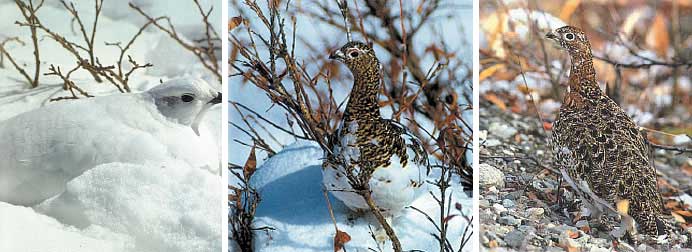 |
| These snow grouse are examples of how camouflage can change according to season. |
While some birds become completely white in winter months, they take on a new appearance in spring matching the colour of the ground and vegetation.
Warning Colours
Living creatures make use of colour for varied purposes. Using it as a mean of warning is one of these purposes. In the following pages, we will give some examples of this.
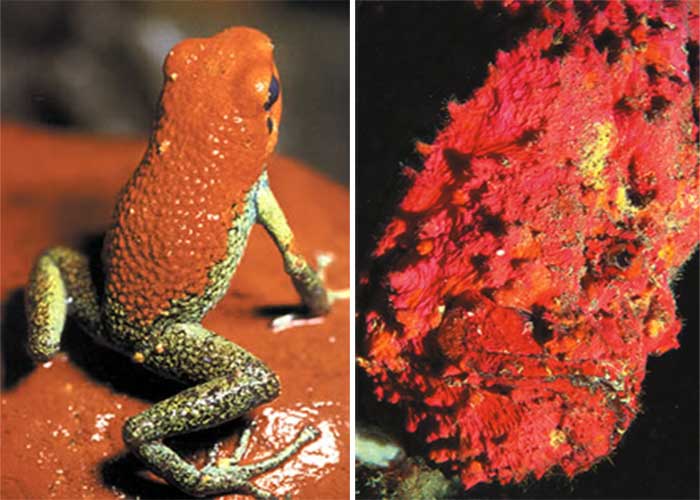 | |
| One of the most threatening frogs is the "poison arrow" frog. This small amphibian of the Dendrobates species has a poison known as "batracotoxin" within its skin, which is believed by some to be the strongest known poison in the animal kingdom. The frog's name is derived from the use made of it by certain Amazonian tribes. It is so poisonous that the Indians used it on the tip of their arrows while hunting.32 The colour of the animal helps other animals to recognise that it is poisonous. | The members of the Sinanceidea species are fish with relatively small and compact bodies. They have no scales, and instead their skins are covered with wart-like protuberances, which perfectly camouflage the fish as they rest upon the seabed waiting for prey. These protuberances break up the outline of the body, which thus come to resemble rocks. Often these fish camouflage themselves even more by burrowing into the sand.33 |
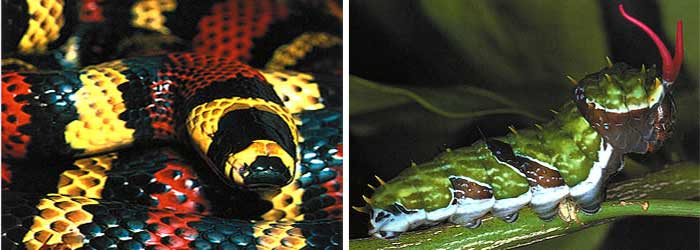 | |
| In South America, there are many poisonous and non-poisonous snakes that share the same vivid coloration. They are all covered with yellow, red, and black rings. They are all called coral snakes. Some of them, the true coral snakes, are deadly. Others, which are called "false corals", only imitate the poisonous ones. The actual arrangement of the coloured bands distinguishes one from the other. The false coral snakes benefit from this similarity and are protected from their enemies.34 | A papilionida extends its red, antenna-like osmeterium (above), an organ that some butterfly caterpillars release when they hear the enemy approaching. The movement of this brightly coloured extension frightens small birds.35 |
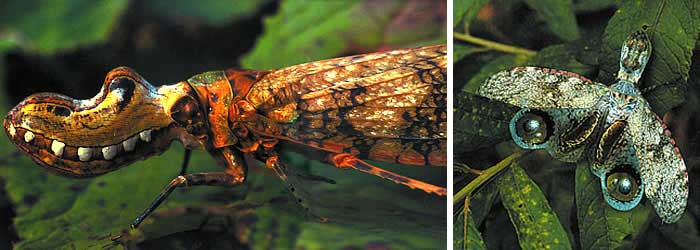 |
| The fulgoridae are a species of often brightly coloured large homoptera that live in the tropics. Their heads extend out in the form of a hollow "horn". The species of fulgoridae has a horn-like growth on its head that imitates the open mouth (complete with teeth) of a crocodile. (Big picture) It is believed that the function of these horn-like extensions may also relate to courtship. The camouflage of the fulgoridae in repose as seen in the smaller picture resembles the bark of a tree. When disturbed, it opens its wings to reveal two large "eyes". This surprises its enemies and gives the animal the chance to run away.36 |
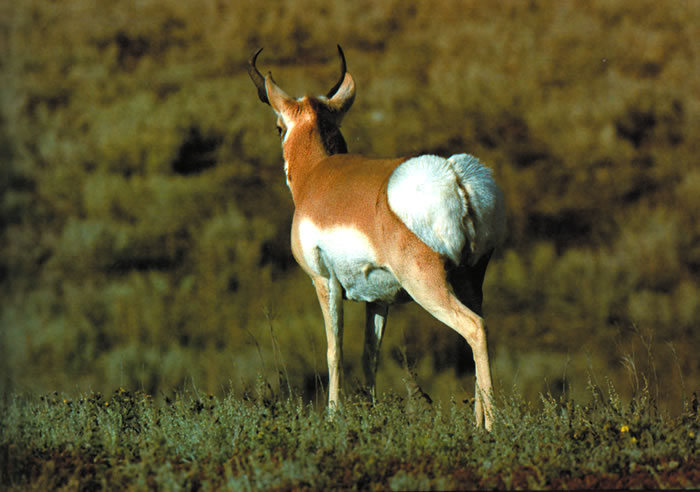 |
| Some animals use hairs of different colours in certain parts of their body as alarm signs. For instance, when pronghorn antelopes sense danger, they broadcast warnings to each other with their buttocks. Each haunch carries a patch of white hair underlain by a disc of muscle. In case of danger, it contracts the muscle so causing the long hairs to spread out into a huge rosette, which reflects light with particular efficiency. When the muscle relaxes, the disc contracts immediately. So bright white flashes are produced that are visible to other pronghorns even kilometres away.37 |
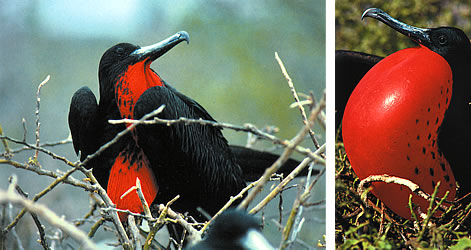 | A male frigate-bird in the Galapagos Islands inflates the scarlet pouch beneath its bill to attract a female. The males often gather in groups upon the mangrove, where they will later build their nests, and engage in this behaviour so that the females flying overhead can choose their partners. The scarlet colour of the pouch contrasts sharply with the black feathers on the upper part of the bird's body, which have a metallic sheen.38 |
 |
| Not all animals use their colourings for purposes of camouflage. Pheasant and peacock males use their coloured feathers to attract females of the species. When a male peacock spreads its tail feathers, a glorious scene is revealed. |
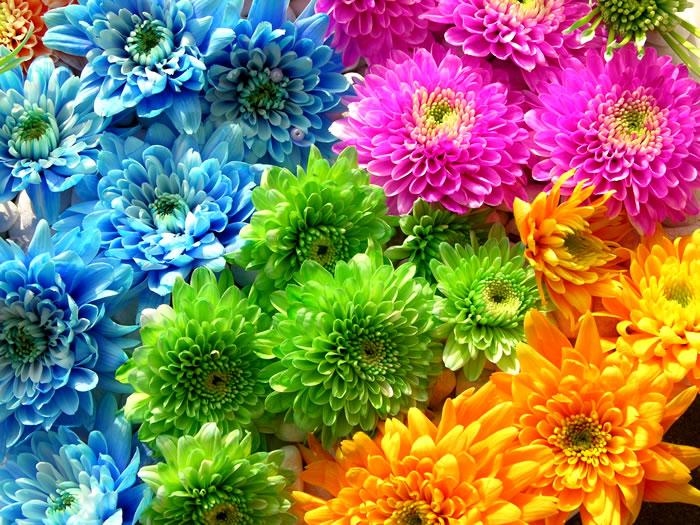 |
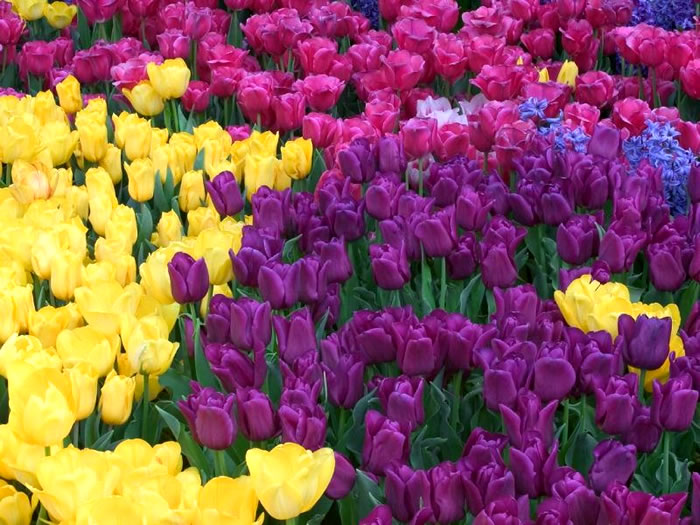 |
| By means of their colourings, living beings attract their mates for purposes of reproduction, or to warn or frighten their enemies or rivals. For instance, flowers, which need pollination for reproduction, are adorned with bright colours and complex patterns in order to attract insects that carry pollens. |
there are signs for people who use their intellect.
(Surat al-Baqara: 164)
Colours in Birds
One of the most important features of the multicoloured feathers of birds is that they are lifeless structures. The reason why a feather maintains its colour exactly, even after it is shed, is that a fully developed feather is completely lifeless.
Rich colour diversity in birds is basically due to the presence of pigments in the feathers, which were stored during the initial development phases of the feather, or the light shifts which occur depending on the structural characteristics of the feathers.
Since these formations, which are made up of the substance keratin, are soon worn down by environmental conditions, they are regularly renewed. Yet, each time, the bird regains its colourful feathers. This is because the feathers of birds continue to grow until they fully reach the necessary length, and the characteristic colour and pattern of that specific kind.
Due to their different structure, feathers can have an appearance similar to that obtained by a glass prism breaking light into different colours. Colours that are formed through refraction of light in this way are brighter and more metallic than those that are coloured by pigments. The colours of these feathers shift from blue to green, and from orange to red. Generally, the green, blue, and metallic colours in birds are formed through the reflection and refraction of light. Yet, some of the colours of feathers come from pigments.39
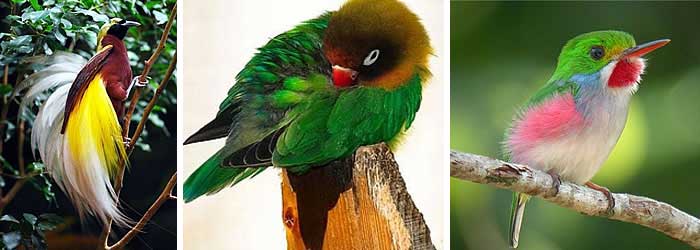 |
| Every bird species has a different colouring. The reason for this colour diversity is due to the light shifts in feathers and the presence of a pigment substance, called keratin, in the structure of the feather. |
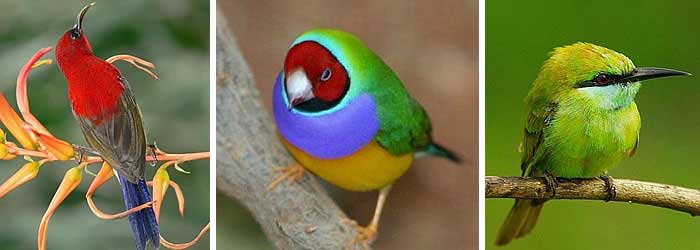 |
| Birds' feathers are lifeless structures that are continuously renewed. At every renewal, the same colours are produced again. |
There are mainly three kinds of pigments in birds. These are melanin pigments that produce black, brown or dull yellow, lipochrome pigments that produce red, yellow or orange, and carotenoids.
Blue, green and some other bright colours in birds are created by microscopic bubbles in the keratin of the feathers that refract the light. The feathers absorbing the full spectrum of light and only reflecting blue, on the other hand, creates the blue colour of some birds.40
Hormones also play an important role in colour change in birds. The colour difference between the male and female members of some species is caused by sex hormones. The different colourings and feather shapes of cocks and hens, for example, depend on the oestrogen hormone.
The colours of birds are important for their adaptation to their habitat as well as for male and female members' recognition of each other and the males' courtship of females in the mating season. In addition, pigments, which give colour to feathers, enhance the strength of the feathers, store energy coming from the sun and prevent harmful ultraviolet rays from entering the body.
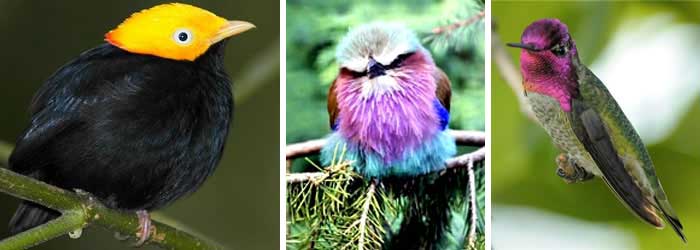 |
| No, everything in the heavens and earth belongs to Him. |
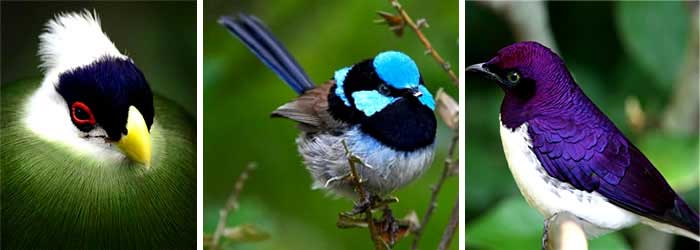 |
Butterflies
Formation of colour in the wings of butterflies is quite interesting. The light is reflected through the scales on the wings of a butterfly forming colours which are "actually non-existent" but which display an extraordinary symmetry and beauty. We just said that they are "actually non-existent", you wonder why?
Butterflies are known for the beauty of their wings that have surfaces that are relatively much wider than their thorax. How, then, do these spectacular patterns and colours in the wings of butterflies come about?
Butterflies have a pair of membranous wings, which are in fact transparent. Since these are covered with scales of varying thickness, the transparency of the membranous wings goes unnoticed. These scales increase the aerodynamic qualities of the butterflies' wings, and give them their colour. The scales, which are so delicate as to fall from their places as soon as they are touched, have sharply-pointed ends sticking into the wings of the butterfly. In this way, the scales remain attached without falling off. Each of these tiny scales, which seem like overlapping shingles on a roof, take on a colour either by chemical pigments or by its structure which refracts the light falling onto it into rainbow colours as does a soap bubble.41 In addition, laboratory research has shown that different colours depend on different chemical substances. The by-products of a colouring substance called pteridine, for example, create the pink, white, and yellow colours that are commonly seen in butterflies. Melanin, which is a very common colouring substance, exists in the black spots in the wings. Interestingly, the colours in the wings of butterflies are not always as they seem to be. For example, green scales are in reality a mixture of black and yellow scales. Recent research conducted on butterfly wings has demonstrated that pigments are synthesised in the scales and that the enzymes necessary for melanin production lie in the upper skin of the scales.
 |
 |
Colouring substances are not the only cause of these highly volatile colours in butterflies. The structure and the order of the scales on the wings of the butterfly cause various tricks of light, such as reflection, refraction, and finally the formation of colours of dazzling beauty. For instance, Stilpnotio Salicis butterflies have semi-transparent scales, which contain bubbles. Although there is no colouring substance in these scales, the light passing through the scales give the butterfly a satin-like appearance.
The surface of the scales on the Argynnis butterfly's wings is unbelievably soft, which creates silvery reflections. In some butterflies, the different arrangement of two overlapping rows of scales may also create different reflections of light, for example, causing a butterfly to look blue instead of black or brown. When we examine the structure of butterfly wings even by considering their colourings alone, we come across lots of wonders. The existence of such an extraordinary beauty is undoubtedly evidence of the exalted might and endless artistry of Allah, Who has created all these.
It also must be stated that besides their being created as adornment, the colours and patterns on the wings of butterflies have many other crucial functions for these creatures.
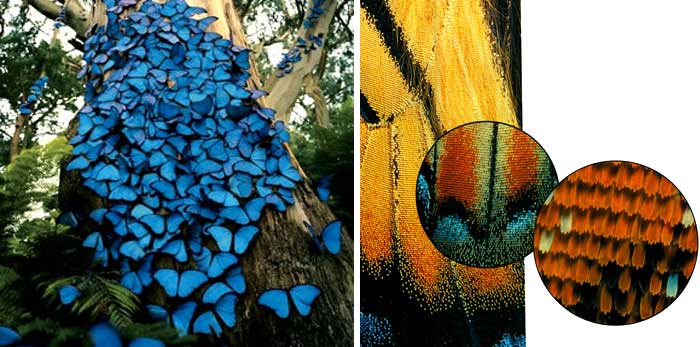 |
| A close-up of the scales on the wings of butterflies |
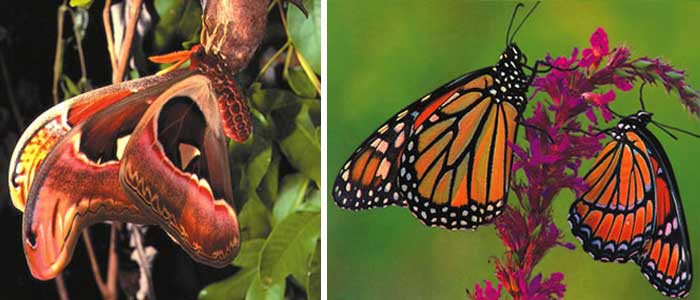 |
| The large Indonesian butterfly (left) has two large spots resembling eyes on its wings, which it uses to startle its enemies. It is a satisfactory defence for these butterflies. Other species such as Monarch butterflies, on the other hand, take recourse to other methods (right). With their dark orange wings with black patterns, they send "bad taste" warning to their enemies. |
False Eyes of Butterflies
In many butterflies, there are round dark-coloured patterns that remind us of the eyes of a large creature. These eyes, which again consist of coloured scales on the wings, embody a most important defence mechanism for butterflies. Butterflies keep their wings closed when they rest. If they meet an enemy, or are disturbed by a slight touch, the wings instantly open, and large, bright, intensely coloured eyespots on the wing surface appear. In this way, the required message is delivered to the predator.
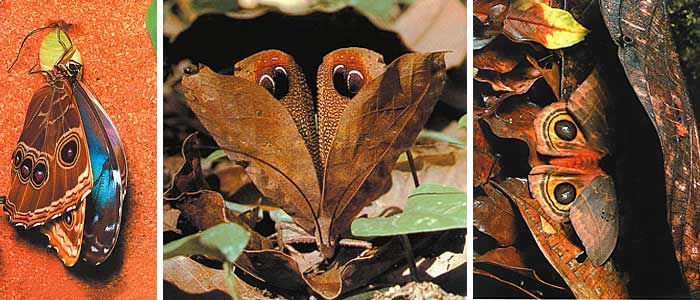 |
| The butterflies seen in the photographs utilise camouflage both with colour and pattern. Allah created the eye motifs on the wings, not lacking even the sparkles in the eye. |
Camouflage of Butterflies
Butterflies' camouflaging skills are as impressive as their false eyes. It is as if camouflaging butterflies see the colour of the bush, make an evaluation of the environment, analyse it, and imitate the colour of the bush with the colours they produce in their bodies' highly effective systems. Another species, aware of the tastes of its predator, gives warning signals to it by imitating colours that repel it by suggesting that the butterfly would taste bad or even be poisonous. It is by no means possible for a butterfly alone to perform these acts. We can make it clearer with an example:
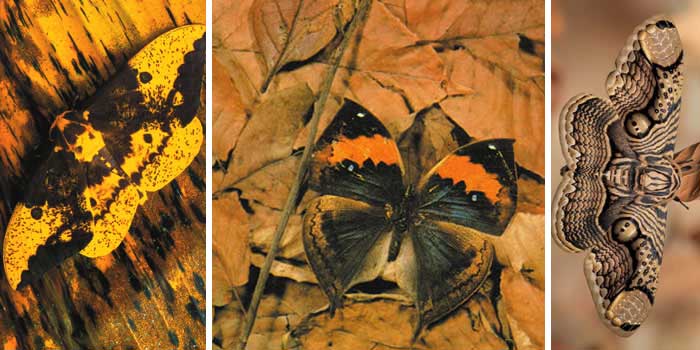 |
| The colours of the butterflies seen in the photographs are in fact very striking. However, both live in safety due to the harmonious they blend in with the substratum on which they pose. |
Suppose that you are trying to produce a colour in a laboratory. If you have little knowledge of this subject, you will not be able to achieve the definite result that you wish, no matter how advanced your laboratory equipment or facilities. Then consider trying to achieve the quality of colours such as those of the butterflies, which, by developing the same colours and patterns as the environment, become almost invisible. You would not be able to develop even a single meaningful colour. The situation being so, it would be certainly an unscientific and irrational approach to claim that this glorious system in butterflies has come into existence by chance free of conscious design. If there is a design somewhere, there is also a designer. The flawless design on the earth belongs to Allah, the Compassionate. What falls to people with reason is to reflect upon Allah's attribute of creating in detail. In Surat an-Nahl, Allah states as follows:
(He has made subservient to you) also the things of varying colours He has created for you in the earth. There is certainly a Sign in that for people who pay heed. (Surat an-Nahl: 13)
Black Spots that Absorb Light
In some butterflies, especially on the parts of their wings that are near to the body, there are large, dark coloured spots that consist of scales. These spots, placed on both wings symmetrically, have a very important function for butterflies. Butterflies make use of these spots in order to reach the body temperature that is required to fly. How do they do this?
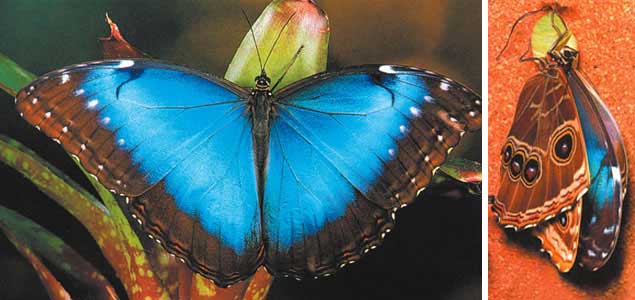 |
| The brown colour and spots under the wings of the blue Morpho butterflies provide an excellent means of camouflage for hiding in the bush. Butterflies may all of a sudden become invisible in the bush. |
Scales have the properties of modifying heat to minimum or maximum levels depending on their colours. We have all seen butterflies opening and closing their wings under the sun as if they are trying to find a certain angle. The black spots in their wings help those butterflies, which try to attract sunlight by this movement. A butterfly that needs to warm up its body opens and closes its wings so that the sunlight falls directly on these spots, and therefore warms up its body.
Butterflies that live in open lands exposed to sun have lighter colours while those that live in wooded areas have darker colours.
Some species of Lepidoptera butterflies have no scales on their wings, cannot reflect light, and so are transparent. Though it is possible to see these butterflies while they fly, it is almost impossible to locate them when they alight somewhere. This provides a perfect protection for the butterfly. Just as all other creatures, butterflies have also been created with the systems with which they can meet all their needs. Moreover, all these are interdependent systems in which one cannot exist without the other.
Like all other creatures in the universe, Allah created butterflies too with all the details they possess and endowed them with all the systems they need.
Colours of the Undersea
Life under the surface of the sea is very different from on land. All the features of sea-dwelling creatures are organised in such a way as to enable them to live in water in the easiest way possible. Humans cannot see in water as well as do fish, because the human eye does not have the features that would allow it to attain sharp eyesight underwater. The human eye does not have a lens system such as that of the fish, and is not spherical and hard like that of a fish, so it does not have as sharp sight underwater as the fish. It cannot allow as precisely as fish do for foreshortening of distances in the water due to refraction, as it cannot estimate the refraction of light in water.
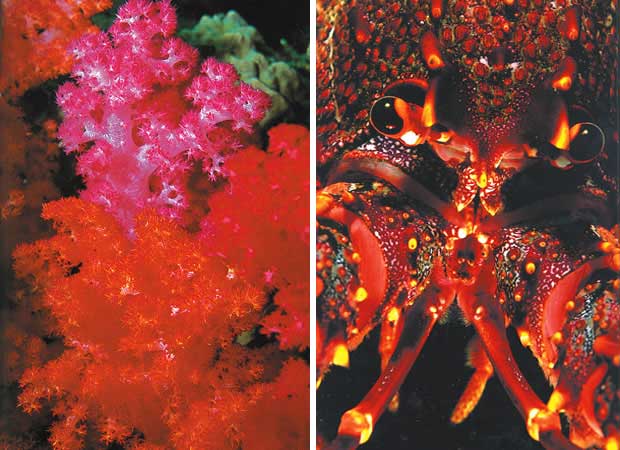 |
| The photograph on the left belongs to a rock lobster. This lobster, a perfect example of harmony in colour and design, is adorned with shades of red.43 Above is a coral. Billions of corals lie together. They combine with each other by special secretions, and form a limestone skeleton. On this skeleton, they secrete a coloured substance: red, pink, and occasionally black or white. |
Allah has created every living being with the most suitable characteristics for the environment it inhabits. Creatures living under the sea constitute only a small part of the examples of Allah's artistry in creation. Allah has no partner in creation and everything is under His control.
There is no other god besides Allah. Allah – He is the Almighty, the All-Wise. (Surah Al 'Imran: 62)
 | |
| The Trinidaian is only one of the colourful creatures of the deeps. These fish that live hundreds of metres below the surface of the sea display Allah's artistry in colour. Allah is also the Ruler of the seas. | A shrimp moves undisturbed along the surface of a sea anemone. The transparency of these small crustaceans is extraordinary, because in most transparent animals some major part of the body still remains visible. For example, most cannot manage to conceal their digestive systems and the food contained inside them. In some species, only the tail and a part of the pincers are coloured. These small details of colour are useful in enabling the shrimp to "disappear"; the contrast between the transparent parts and the colourful markings is so pronounced that would-be predators are drawn to the markings themselves and are not able to perceive the over-all outline of the animal.42 |
 |
| In the depths of the sea, starting from 200 metres below the surface, there is no light at all. However, when reaching the bottom of the oceans, which are even deeper than the height of Everest, we come across a multicoloured world. The striped anemone fish, which live in anemone plants, seen in the photograph above, are also members of this world. |
 |
 |
| Sea cochlea (Nudibranches) is one of the most interesting animals of the underwater world. With their interesting designs and extraordinary colours, these animals are a species of cochlea without a shell. On the pictures above are examples of a few species. These creatures, which have soft bodies, are protected by a strong poison. Their striking colour warns their predators that they are very poisonous. They obtain their poison from the plants they eat.44 |
 | |
| The members of the Sinanceidea species are fish with relatively small and compact bodies. They have no scales; instead their skins are covered with wart like protuberances, which perfectly camouflage the fish as they rest upon the seabed waiting for prey. | Spider crabs are remarkably diverse in size and shape. They range from gigantic Japanese Spider Crab, with metre-long legs, to the miniature coral-reef species seen aboves. Their patterns blend remarkably well will the poly-studded texture of their hosts. |
 |
| One of the most curious and useful features of molluscs is their so-called "cloak" – the tissue that covers their bodies and forms a "second shell". As the photograph reveals, the cloak slowly covers the shell and interrupts the chromatic uniformity that could betray the animal's presence.45 The body of the seahorse (left) is covered with plaque-shaped bones. Seahorses are not very good at swimming. For this reason, they live by clinging to corals. Since seahorses can change their colour quickly, they are easily protected from their enemies. |
 |
| Scorpion fish live along the seabed in temperate or tropical zones and never venture out to open sea. They are carnivorous and feed on smaller fish. The long, fan-shaped pectoral fins are an excellent deterrent to the fish's enemies, and the red-and-white stripes make it difficult for their prey to see them against a backdrop of coral.46 Scorpion fish have a very colourful appearance but can easily become invisible among the corals, which are also very colourful. The members of the Soleidea species, such as soles and rhombuses (left), are extremely mimetic. Their benthic (i.e., bottom-dwelling) nature forces them to imitate the substratum as much as possible. The crocodile fish (right) uses its colour to hide from predators.47 |
 |
| An octopus, photographed at night, makes its skin flare to appear larger. This iridescent green colour is seen almost exclusively after dark.48 Some species can become at one with the deep-sea underwater patterns. Crinoids, seen on the left, are sea tulips in the shape of lilies. They have long, thin, flower-like spiked arms. There is poisonous mucus on their arms. They absorb the oxygen in water through their arms by filtering it.49 |
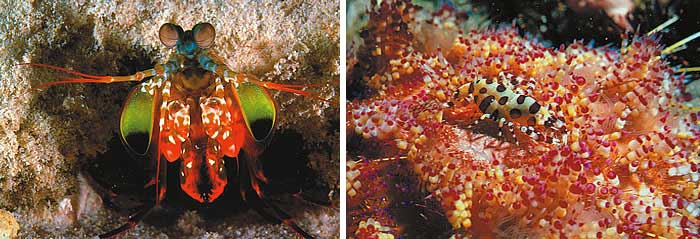 |
| The mantis shrimp (seen above) is only one of the creatures of the undersea that has an interesting appearance and bright colours. Its protruding eyes are among the most complex eyes in nature. |
In the heavens and earth, there are certainly Signs for the believers. And in your creation and all the creatures He has spread about there are Signs for people with certainty. And in the alternation of night and day and the provision Allah sends down from the sky, bringing the earth to life by it after it has died, and the varying direction of the winds, there are Signs for people who use their intellect. Those are Allah's Signs We recite you with truth. In what discourse, then, after Allah and His Signs, will they believe?
(Surat al-Jathiyya: 3-6)
Design of Colours in Plants
If one does not reflect, one cannot see the miraculous characteristics of the living beings around one. So long as one does not think about how a butterfly with its membranous wings flies, how the flowers one sees have such diversity of colour, how the top branches of hundreds of metres tall trees remain green, one cannot grasp the subtleties of these. Even the extraordinary artistry in a flower may not capture one's attention.
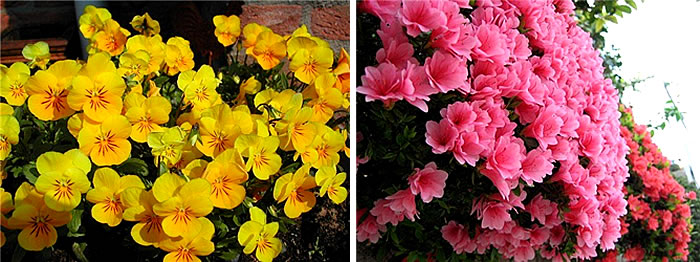 |
As we examined throughout this book, however, perfect artistry is clearly displayed in all living beings from insects to birds, from plants to sea creatures. Certainly this artistry belongs to Allah Who is the Creator of all living things.
Let us think about plants, fruits, vegetables, flowers, and trees. Plants, each having different colours, fragrances and tastes, are evidence of the artistry in creation of Allah. Each plant you see around you or know from books has colours and patterns that are exclusive to its kind. The reproductive process of each is different, the proportions of nectar they contain and their fragrances are all different. Let us think about roses. There are red, white, yellow, orange, pink, white edged, double-coloured, even roses with wavelike colours. Certainly, it would be great blindness for a man who sees all this not to feel admiration for and not to glimpse the endless might of Allah, Who is the Creator of all these flowers. In the Qur'an, Allah refers to those who fail to appreciate the evidence of the creation they see as follows:
How many Signs there are in the heavens and earth! Yet they pass them by turning away from them. Most of them do not have faith in Allah without associating others with Him. (Surah Yusuf: 105-106)
Have you ever thought about why plants are green?
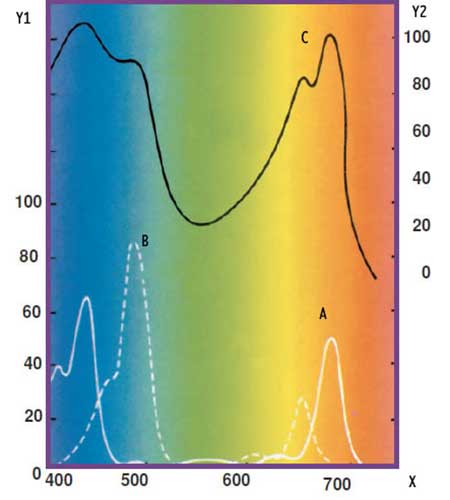 |
| X. Wavelength |
| The dashed and solid white curves below illustrate the absorption spectrum of chlorophylls a and b. The black curve at the top illustrates the effectiveness of various wavelengths of light in powering photosynthesis. The figure reveals how closely the combined absorption spectra of chlorophylls a and b resemble the action spectrum of photosynthesis. 51 |
As is obvious, the colours prevailing in the world of plants are green and shades of green. Chlorophyll is the main substance producing green. Chlorophyll, a very important substance, is a pigment contained in the chloroplasts scattered out in the cytoplasm of the plant cell. These pigments absorb light coming from the sun easily, but only reflect the colour green. In addition to giving the colour green to leaves, this feature also causes the fulfilment of a crucial process called "photosynthesis".
In photosynthesis, plants utilise sunlight, which consists of the combination of different colours. One of the most important properties of the colours in sunlight is that their energy levels are different from one another. This assortment of colour called the spectrum, which is obtained by the refraction of colours in a prism for example, has red and yellow tones at one end, and blue and violet tones at the other end. Colours with the highest level of energy are those colours at the blue end of the spectrum.
The difference in the energy levels between colours is very important for plants, because they need large amounts of energy to make photosynthesis. For this reason, during photosynthesis, plants absorb those sunrays of the highest energy levels towards the ultraviolet end of the spectrum, i.e. violet and blue, as well as the colours that are more towards the infra-red (heat) end of the spectrum, i.e. red, orange and yellow. Leaves carry out all these processes through the chlorophyll pigment existing in the chloroplasts.52
For a plant to photosynthesise, the energy levels of the light particles that are absorbed by the substance chlorophyll must be adequate. The process of photosynthesis begins when a plant, with the energy it receives from light particles, breaks the water molecules into oxygen and hydrogen molecules. Hydrogen reacts with carbon in the carbon dioxide gas to form the sap of the plant, which is essential for the plant to survive. In other words, the plant produces its own food. Unused oxygen, on the other hand, is released to the air. Most of the oxygen we breathe in the atmosphere is produced that way.
As a result of the process of photosynthesis in plants, they produce carbohydrates, one of the main food sources for other living things. The substances produced during photosynthesis are extremely important for plants themselves as well as for animals and humans, because plants are the main source of food of all living things on earth.
As we have seen, besides providing an aesthetic appearance, the green colour of plants is also extremely crucial for the survival of both plants and other living creatures. Allah makes the substance chlorophyll a cause for the nourishment of plants and the sustenance of all other living creatures.
 |
How do the Different Colours in Plants Come About?
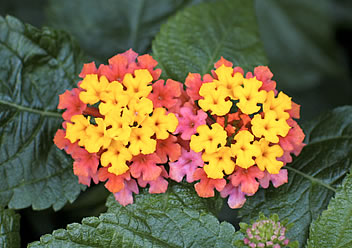 |
| Chlorophyll is the main substance producing green in plants. Allah makes this substance a cause for the nourishment of plants and the sustanence of all other living creatures. |
As mentioned before, the colour reflected by each object depends on the pigment molecules that object has. The basic pigment molecule in green plants is the substance "chlorophyll" as earlier stated. In addition to this, there are other pigments producing other colours in plants, and these different kinds of pigments form the extraordinary colour diversity we see in plants.
For example, in addition to chlorophyll, there are also carotenoid pigments in plants. Some of these pigments, which we have examined in detail before, are yellow and give colour to ears of corn, lemons, goldenrod and sunflowers. Other carotenoids are much more red than yellow; these are found in beets, tomatoes, roses, and carrots. Carotenoids are also present in green leaves. Then one might wonder: why do leaves not look red, yellow or orange but are mostly in shades of green? The reason is that the green of the chlorophyll is so strong that other colours cannot be seen.53
However, changes occur in the autumn. As the hours of daylight become shorter, plants stop making chlorophyll, and the strength of the pigments producing the colour green decreases, causing the green colour of leaves to fade. The carotenoids, becoming visible now, colour the leaves brown, yellow, and red. Also in the autumn, a group of pigments called "anthocyanins" form in the outer layers of certain leaves. These pigments, which are bright red and blue, combine with the others to give leaves the crimson and purple hues we occasionally see.54
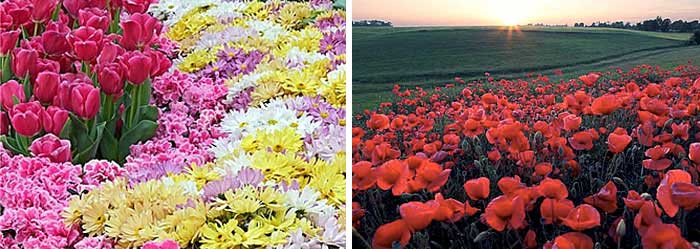 |
| Everywhere in the world, the same kinds of flowers have the same colours and patterns that are exclusive to their kinds, and this fact rarely changes. |
Information about all the pigments giving colour to a plant is coded in the DNA of that plant. For this reason, a plant species bears the same characteristics no matter where on the earth. For example, everywhere in the world the colour of oranges is the same; their shape and the structure of their peels are the same. The colour of the transparent membrane, which lies inside the peel of the orange, and which constitute little sacs filled with orange coloured, perfumed sugared water, never change anywhere in the world. Bananas are everywhere yellow, tomatoes are red, and roses, violets, and carnations are all the same colours wherever they are. Wherever you go in the world, you will not see a naturally growing strawberry with a different colour. Everywhere in the world, the DNA of strawberries contains the characteristics that make them the strawberry we know. The colour, smell and taste of a strawberry are always the same. It is a unique, unparalleled order. Certainly, it cannot be claimed that such a system has come into existence by sheer chance.
The owner of this matchless artistry that prevails all over the world is Allah, Who has infinite wisdom. Allah has power over all things.
Have you ever thought how such diversity of colour comes about in plants although they all grow in the same soil and are watered with the same water?
In Surat ar-Ra'd, Allah draws attention to the fact that although all watered with the same water, different crops come out of the soil:
In the earth there are diverse regions side by side and gardens of grapes and cultivated fields, and palm-trees sharing one root and others with individual roots, all watered with the same water. And We make some things better to eat than others. There are Signs in that for people who use their intellect. (Surat ar-Ra'd: 4)
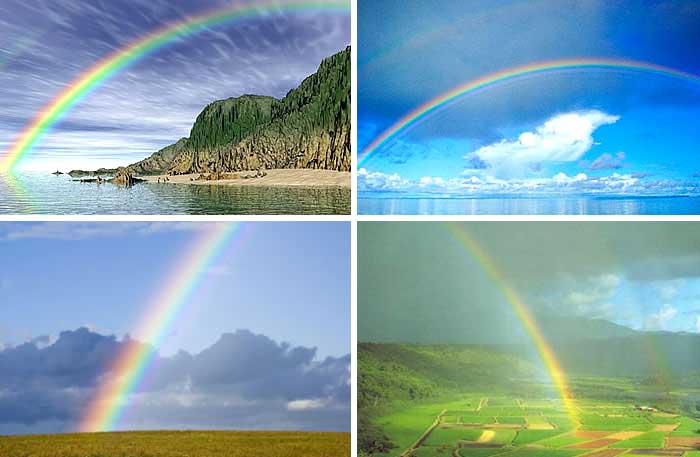 |
| Rainbows in which the colour spectrum can be seen in a neat order are in fact an illusion of colour. Rainbows are formed by sunlight refracted through raindrops. |
As Allah has drawn to our attention, let us ponder, by looking at the vegetables and fruits around us, how different crops come out of the same soil. For example, let us look at melons, watermelons, kiwis, bananas, cherries, eggplants, tomatoes, grapes, peaches, and green beans. When you peel the dark yellow skin of a banana, out of it comes a banana of a lighter yellow with its matchless fragrance. The red, green or yellow peel of an apple has a smooth sheen. Humans cannot imitate the quality of the taste and smell, an aroma particular to it, of its sweet juice.
 |
| That is Allah, your Lord. There is no god but Him, the Creator of everything. So worship Him. He is responsible for everything. |
 |
| This is Allah's creation. Show me then what those besides Him have created! The wrongdoers are clearly misguided. |
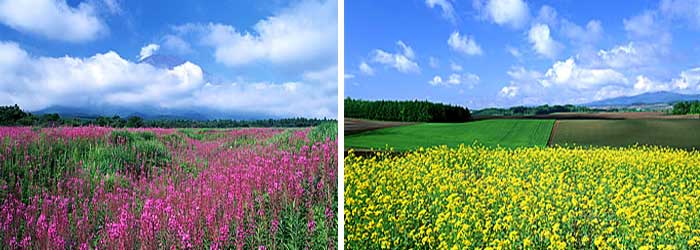 |
| It is Allah Who created the heavens with no support – you can see them – and cast firmly embedded mountains on the earth so that it would not move under you, and scattered about in it creatures of every kind. And We send down water from the sky and make every generous species grow in it. |
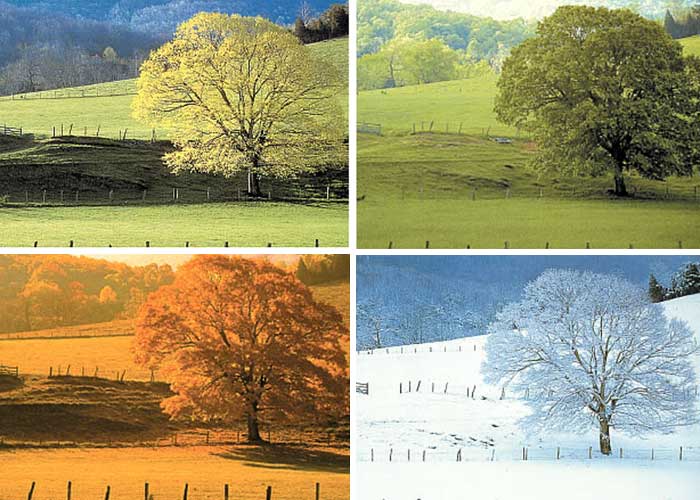 |
| In nature, there is a diversity of colour that changes according to the seasons. Mountains, trees, lakes, rivers, in short, all nature is evidence of the unparalleled artistry in colour of Allah. |
Then, the question may occur to one: how do all those flowers, trees, vegetables and fruits have so many different colours although they come out of the same arid soil? This is evidence of the endless knowledge of Allah and His creating without any preceding model. It is impossible for man to create a new colour. All colours produced by people are only copies of the originals existing in nature. However, Allah is the Originator, and the creation of all the colours describing the living creatures on earth is His. Allah's artistry in creation is matchless. One of the names of Allah, the All-Powerful, is al-Musawwir – the One Who forms His creatures in different forms. Allah creates everything He creates in the most perfect forms.
He is Allah – the Creator, the Maker, the Giver of Form. To Him belong the Most Beautiful Names. Everything in the heavens and earth glorifies Him. He is the Almighty, the All-Wise. (Surat al-Hashr: 24)
The colours and appearance of all plants on the earth have been created in such a way as to appeal to the human soul. In fruits and vegetables, there is a matchless diversity of colour. On the other hand, when we think of flowers and trees we again see the same aesthetic appearance and diversity of colour.
 |
 |
 |
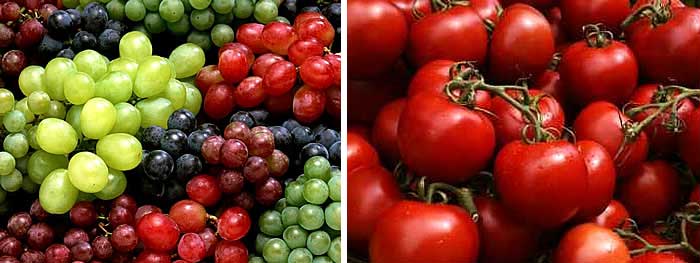 |
 |
| All of the fruits and vegetables you see in these pictures, which have different shapes and colours, grow in the same dry soil and are watered with the same water. Yet, each of them has a colour, taste and smell, particular to its kind. Allah has created each one of them uniquely and bestowed them upon us. |
There is also a totally unequalled colour and pattern design in flowers. Each of the hundreds of thousand kinds of flowers has been furnished with particular characteristics exclusive to its kind. Today, the perfumes, patterns and colours produced by men are all imitations of their original counterparts in nature. For instance, the purple colour of the leaves of violets, which are soft like velvet, and the smoothness of the surface of their leaves are matchless. Velvet fabrics are produced in imitation of the texture of violets but a similar quality can never be achieved.
With this approach, no matter what plant we examine on the earth, the conclusion we arrive at is that it is a perfect creation. Allah, Who has no partners in creation, creates plants for men with different tastes, fragrances, colours and forms. What falls to us is to reflect on the signs Allah creates and to be grateful.
 |
 |
| In autumn, different pigments in the leaves are released and shades of yellow and red dominate the colour of the plants. |
Footnotes
16. David Attenborough, The Life of Birds, Princeton University Press, New Jersey, 1998, p.263
17. Marco Ferrari, Colors for Survival, Barnes and Noble Books, New York, 1992, p.41
18. Marco Ferrari, Colors for Survival, Barnes and Noble Books, New York, 1992, p.52
19. Marco Ferrari, Colors for Survival, Barnes and Noble Books, New York, 1992, p.20
20. Marco Ferrari, Colors for Survival, Barnes and Noble Books, New York, 1992, p.26
21. Marco Ferrari, Colors for Survival, Barnes and Noble Books, New York, 1992, p.71
22. Marco Ferrari, Colors for Survival, Barnes and Noble Books, New York, 1992, p.76
23. Jill Bailey, Mimicry and Camouflage, BLA Publishing Ltd., England, 1988, p.17
24. Marco Ferrari, Colors for Survival, Barnes and Noble Books, New York, 1992, p.85
25. Marco Ferrari, Colors for Survival, Barnes and Noble Books, New York, 1992, p..25
26. Marco Ferrari, Colors for Survival, Barnes and Noble Books, New York, 1992, p.48-49
27. The Guinnes Enyclopedia of Living World, 1992, p.16
28. Marco Ferrari, Colors for Survival, Barnes and Noble Books, New York, 1992, p.86-87
29. International Wildlife, September-October 1992, p.34
30. Jill Bailey, Mimicry and Camouflage, BLA Publishing Ltd., England, 1988, p.18
31. Dr.Harold Cogger&Dr. Richard Zweifel, Enyc. of Reptiles&Amphibians, 1998, p.388
32. Marco Ferrari, Colors for Survival, Barnes and Noble Books, New York, 1992, p.64
33. Dr.Harold Cogger&Dr. Richard Zweifel, Enyc. of Reptiles&Amphibians, 1998, p.200
34. Marco Ferrari, Colors for Survival, Barnes and Noble Books, New York, 1992, p.129
35. Marco Ferrari, Colors for Survival, Barnes and Noble Books, New York, 1992, p.126
36. David Attenborough, The Trials of Life, Princeton University Press, New Jersey s.235
37. David Attenborough, The Life of Birds, Princeton University Press, New Jersey, 1998, p.193
38. David Attenborough, The Life of Birds, Princeton University Press, New Jersey, 1998, s,158
39. David Attenborough, The Life of Birds, Princeton University Press, New Jersey, 1998, p.158
40. Ranger Rick, May 1999
41. Karl Roessler, Coral Kingdoms, Harry N. Abrams, Inc., Publishers, 1986, p.69
42. National Geographic, October 1989, p.518 .
43. National Geographic, August 1997, p.32 .
44. The Guinnes Enyclopedia of Living World, 1992, p.167
45. Marco Ferrari, Colors for Survival, Barnes and Noble Books, New York, 1992, p.56
46. Marco Ferrari, Colors for Survival, Barnes and Noble Books, New York, 1992, p.122
47. Marco Ferrari, Colors for Survival, Barnes and Noble Books, New York, 1992, p.62
48. Karl Roessler, Coral Kingdoms, Harry N. Abrams, Inc., Publishers, 1986, p.44
49. National Geographic, Aralık 1996, p.118-120
50. Karl Roessler, Coral Kingdoms, Harry N. Abrams, Inc., Publishers, 1986, p.125
51. Temel Britannica Ansiklopedisi, Cilt 7, p.16
52. Franklyn Branley, Color, From Rainbows to Lasers, Thomas Y. Crowell Comp., New York, p.37
53. Franklyn Branley, Color, From Rainbows to Lasers, Thomas Y. Crowell Comp., New York, p.38
